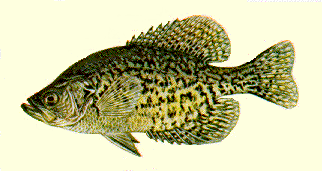
Illustration by Virgil Beck.Black Crappie Distribution: The black crappie occurs in all three drainage basins in Wisconsin (Lake Michigan, Mississippi River, and Lake Superior). This glacial species is well distributed througout the state, except in the streams of the driftless area of southwestern Wisconsin.
Spawning: In Wisconsin, the black crappie usually spawns in May and June; however, during a colder season, spawning may be delayed until July. Favorable spawning temperatures range from 64 to 68º F. The male sweeps out a nest in sand or fine gravel and guards the nest and defends the young until they start to feed.
Angling: The black crappie is considered an excellent game fish when taken on light tackle. Extreme care must be taken in landing these fish because their mouths are very tender. Anglers specializing in catching black crappie know that to be successful the bait must be kept constantly moving. The best baits are small minnows, small maribou- covered jigs, plastic minnows, or small streamer flies cast along the outer edges of weed beds. The crappie lies in weed beds in deep water during the day and bite best in early morning or toward evening. In summer, with the abundance of small fish for feed, they are more difficult to catch. Small minnows are used as bait in winter.
Crappie Bonzana: Try a Fly Many crappie anglers shy away from the fly. With a little practice and a small investment you will be ready for a new experience. Choose your equipment: Today's fly rods come in a wide variety of materials and lengths. Choose the rod that best fits your price range. For crappies, an 8 to 9 foot rod will fit your needs. A single- action reel is the most affordable and will do the job nicely.
The fly line is a vital peice of equipment. Most crappie anglers prefer the lighter lines such as 4 to 5 lb. weight. If using weighted flies a heavier line will work for you. A double taper or weight-forward. floating line and mayched to the weight of the rod will allow for precise presentation. Always attach a 9 foot, 4 to 6 lb monofilament leader to your fly line.
Crappies are very different from the bluegill. Crappies feed mainly on minnows and other small fish. You will catch more crappies if you use flies that mimic this forage. Streamers, tied on long-shank hooks with long feathers are the best minnow imitations. Some good choices are the Clouser Minnow, the Mickey Finn, Black Ghost and the White Marabou Flash.
Select streamers No. 6 to 12 going larger if needed. Crappies feed below the surface so streamers should be tied with wraps of lead weight or with weighted eyes to help them sink.
Along with streamers, try insect imitations. Nymphs like the Gold-ribbed Hare's Ear work well, as do the Black Gnat and Hare's Ear Wet.
Spring Bonzana: Spring is the best time to fly fish. When water temperatures start to warm, crappies head for shallow, dark-bottomed bays to feed. Sometimes they are so aggressive that smack anything that swims by. The fish are shallow so you'll have no trouble reaching them with floating fly line.
Once you locate the crappies, deliver the fly, let it sink a few feet, then begin retrieving the line by hand. Experiment to discover their preference but short strips usually work best. Watch the point where the leader meets the line. This is your strike indicator. Any change in behavior or a sudden twitch - Set the Hook!
Be on the lookout for bug hatches. Various insects shed their cases on the water surface and fly away. Crappies wander a few feet under the surface slurping up the hatching bugs. Wet flies imitate the emerging insects and are most likely to catch you a crappies or more.
Throughout the year try known crappie habitate like brush, timber, tree falls, weeds, stumps or reeds. Cast to the cover and let the fly very slowly then twitch it slightly. Crappies like static baits best.
Not only will you harvest the crappies but you latch on to other species as well.
Have Fun!





